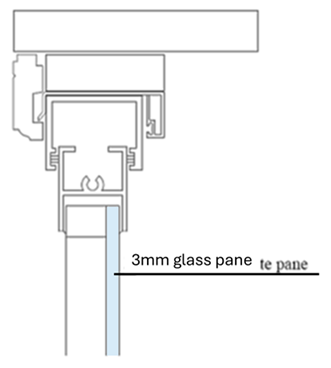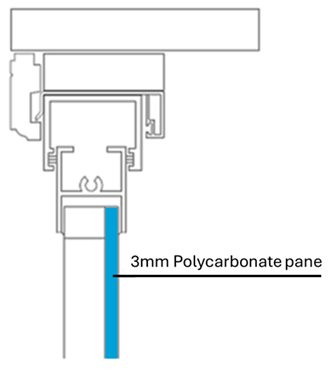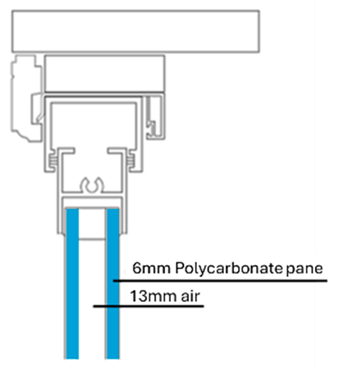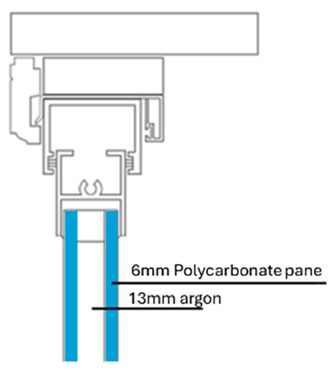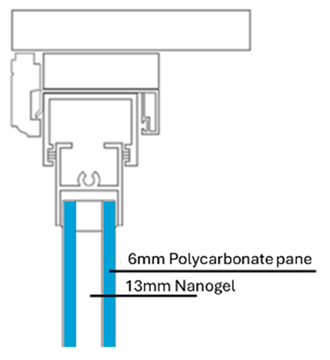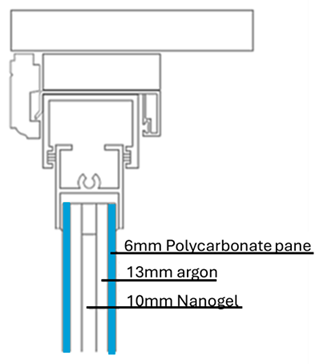Abstract
This study integrates dynamic energy simulation with lifecycle assessment (LCA) to evaluate the energy and carbon performance of advanced glazing systems suitable for hot–arid climates. Using Design Builder software coupled with OpenLCA, six glazing configurations were analyzed under identical building and climatic conditions. The configurations included a conventional single 3 mm float glass pane (C0) as the reference case, a single 3 mm polycarbonate sheet (C1) representing common local construction practice, and four advanced multi-layer systems (C2–C5) incorporating air, argon, and nanogel insulation layers. The inclusion of C0 enabled direct comparison between typical glass construction and emerging polycarbonate-based systems, thereby enhancing the contextual relevance of the analysis. Results demonstrated that thermal and optical properties of glazing systems strongly influence both operational and embodied carbon outcomes. Relative to the conventional glass reference (C0), the nanogel–argon composite (C5) achieved a 32.4% reduction in annual cooling energy and a 28.9% decrease in total lifecycle carbon emissions, with a carbon payback period of approximately 1.1 years. The operational phase dominated total emissions (>97%), confirming that improvements in glazing thermal performance yield substantial long-term benefits even when embodied impacts are considered. While argon filling provided marginal benefit over air cavities, the nanogel insulation contributed the largest performance enhancement. However, the relatively low visible light transmittance (VLT = 0.27) of the C5 system suggests a potential daylight–comfort trade-off that warrants further investigation. The study demonstrates the importance of integrating energy simulation with lifecycle assessment to identify glazing systems that balance energy efficiency, embodied carbon, and indoor environmental quality in hot–arid regions.
1. Introduction
The building sector is a major contributor to global energy consumption and carbon emissions, accounting for nearly 30% of total primary energy use worldwide. In Saudi Arabia, residential buildings alone consume approximately one-third of national electricity, primarily driven by cooling demands under extreme hot–arid climatic conditions []. Summer temperatures in cities such as Riyadh, Jeddah, and Hail often exceed 45 °C, and high solar radiation coupled with low relative humidity results in significant indoor thermal discomfort. Consequently, maintaining acceptable comfort levels relies heavily on mechanical cooling, leading to considerable energy consumption and associated greenhouse gas (GHG) emissions. According to the Saudi Energy Efficiency Center, air-conditioning systems account for roughly 68–72% of total residential electricity use, with an average specific consumption of 240 kWh/m2·yr in hot–arid regions such as Riyadh and Hail. This translates into annual operational emissions exceeding 170 Mt CO2 across the national housing sector.
While the Saudi Building Code has progressively introduced thermal insulation standards and efficiency measures, the focus of most studies and policies remains confined to operational energy performance. Efforts have been centered on improving HVAC efficiency, wall and roof insulation, and shading design, often overlooking the embodied carbon of building materials. As operational energy intensity declines due to technological advances, embodied emissions—originating from material extraction, manufacturing, and transport—are expected to constitute a larger share of the total building carbon footprint []. This shift necessitates a more comprehensive assessment that integrates both operational and embodied impacts.
Emerging façade materials, particularly those integrating nanotechnology-based insulation, present new opportunities to enhance thermal performance and daylight quality simultaneously. Polycarbonate (PC) glazing, when combined with nanogel or aerogel fillers, offers superior thermal insulation and reduces solar heat gain while maintaining adequate visible light transmittance. Previous investigations in Saudi Arabia and other hot–arid regions have demonstrated that polycarbonate-based glazing systems can reduce annual cooling energy by up to 40–50% compared to conventional single glazing [,,]. However, most of these studies evaluated energy savings in isolation, neglecting the embodied carbon implications of using advanced materials. As a result, the net environmental benefits of such glazing systems over their life cycle remain uncertain.
To address this research gap, the present study develops an integrated analytical framework combining dynamic energy simulation and lifecycle carbon assessment (LCA). The framework links operational energy data from Design Builder v5.5.2.007 (EnergyPlus engine v23.2.0) with embodied carbon estimates derived from OpenLCA v2.5.0 using the Ecoinvent v3.9 database. The analysis is applied to a typical two-story residential building located in Hail City, representing a characteristic hot–arid context in Saudi Arabia. Five glazing configurations were evaluated, including single and double polycarbonate panels, argon-filled cavities, and nanogel-enhanced systems. The main objectives of this study are threefold:
- (i)
- To quantify the impact of different polycarbonate–nanogel glazing systems on annual cooling energy consumption.
- (ii)
- To evaluate the embodied and operational carbon emissions over a 30-year service life.
- (iii)
- To identify the optimal configuration that minimizes lifecycle carbon emissions while achieving rapid carbon payback.
By integrating building performance simulation with lifecycle assessment, this research provides a holistic understanding of façade material performance and contributes to the broader goals of sustainable design and carbon reduction under Saudi Vision 2030. Unlike previous regional studies that relied on simplified spreadsheet-based LCA or steady-state energy calculations, this research employs a fully integrated, dynamic simulation–LCA workflow that ensures data consistency between operational and embodied phases. This methodological linkage enables more accurate lifecycle decision-making for façade optimization in Saudi residential contexts.
2. Literature Review
2.1. Glazing Technologies in Hot–Arid Climates
In hot–arid regions, windows and glazed façades play a decisive role in determining building energy demand due to their strong influence on solar heat gain, daylight transmission, and heat transfer. High solar radiation and ambient temperatures elevate cooling loads, particularly in residential buildings, where air-conditioning systems often account for more than 70% of total electricity consumption [,]. As a result, optimizing glazing design has become a key strategy for improving building energy efficiency and mitigating carbon emissions.
Recent studies in Saudi Arabia have evaluated the performance of alternative glazing materials to replace conventional single-pane glass. Polycarbonate (PC) has gained attention as a viable substitute due to its lightweight, impact resistance, and lower thermal conductivity compared with standard glass. Menkabo et al. [] assessed polycarbonate glazing as a sustainable replacement in Madinah and reported 20–28% reductions in annual cooling energy across various thicknesses and configurations. Similarly, Mohammed et al. [] demonstrated that multiwall PC panels could reduce cooling loads by over 35% relative to single glazing, highlighting the material’s potential for hot desert climates.
In addition to polycarbonate, the incorporation of nanogel or aerogel insulation within glazing cavities has shown remarkable promise. Nanogels—silica-based nano-porous materials with low thermal conductivity—effectively minimize conductive and radiative heat transfer while maintaining acceptable visible light transmittance (VLT). A comparative analysis conducted in Jeddah by Gomaa et al. [] revealed that nanogel-enhanced systems can achieve up to 48.6% reductions in cooling energy demand compared with single-pane glazing. Other studies in Egypt and the Gulf region have confirmed similar findings, reporting 11–26% savings depending on the nanogel’s optical and thermal properties [,,,,]. These outcomes collectively demonstrate that advanced glazing systems combining low U-values and optimized Solar Heat Gain Coefficients (SHGC) can substantially reduce energy consumption in hot–arid buildings.
While inert gas filling, such as argon, is commonly used to enhance insulation by reducing convective heat transfer, its incremental benefit under high solar load conditions appears limited. Comparative analyses by Mujeebu et al. [] indicated that, when ambient temperatures exceed 40 °C, improvements from argon are marginal relative to those from SHGC reduction or radiant barrier effects. Consequently, hybrid designs integrating nanogel layers with PC panels and argon cavities are emerging as the most effective configurations for achieving significant thermal performance gains in extreme climates.
The choice of polycarbonate as the glazing substrate, instead of conventional glass, is supported by both its thermal and practical advantages. In addition to its substantially lower thermal conductivity (0.19 W/m K compared with ~1.0 W/m K for glass) and lighter weight—which facilitates easier installation and reduced structural demand—polycarbonate offers high impact resistance, being approximately 200 times stronger than glass of equal thickness. Regarding durability and optical stability, recent studies have shown that UV-protected polycarbonate panels maintain over 90% of their initial visible light transmittance after ten years of outdoor exposure, with minimal yellowing when coextruded with protective coatings. While its surface is more susceptible to scratching than glass, the use of abrasion-resistant hard coatings mitigates this limitation, extending service life beyond 20 years under desert conditions. These combined attributes make polycarbonate a robust and practical choice for façade systems in hot–arid climates, balancing energy efficiency, safety, and longevity.
2.2. Integration of Energy Simulation and Lifecycle Assessment
Although substantial progress has been made in improving glazing performance through material and design innovations, most studies remain focused on operational energy savings. The environmental impact associated with material production, transportation, and installation—collectively termed embodied carbon—has received comparatively little attention in regional research [,]. Globally, however, embodied emissions are increasingly recognized as a major contributor to life cycle building impacts, particularly as operational energy efficiency improves [,]. Recent studies have adopted multi-method frameworks that integrate energy simulation with indoor environmental quality assessments to provide a more comprehensive understanding of residential building performance, particularly in humid subtropical regions [].
Integrating building performance simulation with lifecycle assessment (LCA) provides a more holistic framework for evaluating façade systems. Recent works have further highlighted the importance of coupling energy simulation with indoor environmental quality (IEQ) assessment to ensure that energy-efficient designs also maintain occupant comfort and health standards []. Cabeza et al. [] and Antypa et al. [] emphasized that neglecting embodied impacts can lead to misleading conclusions regarding material sustainability. Recent LCA studies in the Middle East have started to address this gap. Elkhayat et al. [] compared three high-performance glazing systems for office buildings in Cairo using an LCA approach and concluded that operational savings often outweigh the embodied burden within a few years of operation. Similarly, Liu et al. [] evaluated aerogel glazing across different climates and found that carbon payback periods ranged from 1.5 to 5 years depending on the local energy mix.
In Saudi Arabia, however, few studies have simultaneously quantified operational and embodied impacts while also addressing the economic feasibility of advanced glazing options. Abdelhafez et al. [] evaluated polycarbonate glazing in Hail City, focusing primarily on thermal performance without assessing carbon payback or lifecycle costs. In contrast, international research provides more comprehensive insights: Baetens et al. [] reported that nanogel and aerogel glazing systems can achieve 25–45% reductions in annual cooling energy in hot–arid contexts, with simple payback periods ranging between 3 and 6 years depending on local electricity tariffs. Salem et al. [] use Design Builder simulation to assess the energy retrofitting effectiveness of nano-insulating materials, Nanogel Aerogel (for glazing), on an educational building in the hot climate of Alexandria, Egypt. Compared to a traditional window, they saved 15.2% of energy annually.
Furthermore, comparative performance studies reveal that nanogel glazing not only minimizes cooling loads but also contributes to improved indoor thermal stability and reduced glare. However, its relatively low visible light transmittance (VLT = 0.25–0.35) may necessitate supplemental daylight design measures. The integration of such performance and cost evaluations into LCA frameworks remains limited, underscoring the need for studies that simultaneously consider energy, carbon, and economic dimensions—an approach adopted in the present work. Recent studies have highlighted the importance of integrating dynamic energy simulation with lifecycle assessment (LCA) to capture both operational and embodied impacts. Tavares and Freire [] demonstrated through a multi-climate LCA of prefabricated housing that lightweight systems reduce embodied carbon but may increase cooling loads in warm regions, stressing the need for climate-specific optimization. Similarly, Gutai et al. [] emphasized that combining simulation-based energy modeling with LCA provides a more accurate assessment of façade and glazing systems, revealing short carbon payback periods when operational savings outweigh embodied burdens. These findings reinforce the necessity of integrated BES–LCA frameworks for evaluating material and energy trade-offs in hot climates. Table 1 summarizes key studies on advanced glazing and façade systems across different climatic regions.

Table 1.
Comparative summary of previous studies on glazing and façade systems in various climates.
2.3. Research Gap and Novelty
Despite the growing body of literature on advanced glazing materials, two main knowledge gaps persist. First, although several recent studies have begun integrating energy simulation with lifecycle assessment, most still emphasize short-term operational energy savings, with limited consideration of embodied carbon and long-term environmental trade-offs—particularly for residential buildings in hot–arid climates. Second, while a few studies have addressed the environmental assessment of advanced glazing systems, very few have integrated validated energy simulation models with quantitative carbon payback analysis, which is essential to determine the time required for operational savings to offset initial embodied impacts.
The novelty of this study lies in the methodological integration between Design Builder (EnergyPlus engine) and OpenLCA through a unified data-exchange workflow that ensures complete consistency between operational and embodied phases. Unlike earlier regional works that used static or simplified LCA spreadsheets, this research establishes a dynamic link between hourly energy outputs and lifecycle carbon accounting using region-specific emission factors from the Saudi electricity grid. This coupling allows direct quantification of carbon payback periods under realistic climatic, operational, and material conditions—providing a new level of precision for façade optimization in hot–arid climates.
Building on this gap, the present study develops and applies an integrated Design Builder–OpenLCA framework that connects dynamic energy simulation with comprehensive lifecycle carbon evaluation. In addition to addressing the methodological shortfall, it responds to the limited discussion in prior studies regarding cost-effectiveness and payback performance under local energy and climatic conditions. By applying this methodology to polycarbonate, nanogel, and argon glazing systems in a representative residential building in Hail City, the research advances current knowledge in two key aspects:
- It quantifies both operational and embodied carbon over a 30-year life span using region-specific data.
- It establishes carbon payback periods for each configuration, providing actionable insights for façade design optimization in hot–arid climates.
This combined assessment framework aligns with the objectives of Saudi Vision 2030 by promoting low-carbon building technologies and offers a replicable approach for evaluating emerging materials across similar climatic zones.
3. Methodology
3.1. Overview of the Analytical Framework
This study integrates building energy simulation and lifecycle carbon assessment (LCA) to evaluate the environmental performance of advanced polycarbonate-based glazing systems in hot–arid climates. The methodological framework links dynamic thermal simulation in Design Builder v7.0 (EnergyPlus engine) with embodied carbon quantification in OpenLCA v1.11, supported by the Ecoinvent v3.9 database. The workflow consists of four primary stages:
Defining the case study building and local climatic boundary conditions.
Performing energy simulations to estimate annual cooling and total energy demand.
Developing lifecycle inventory (LCI) data for material and energy inputs.
Calculating embodied, operational, and lifecycle carbon emissions, including carbon payback analysis.
Figure 1 presents the schematic framework of the research, illustrating the data flow from energy simulation outputs to lifecycle carbon calculations.
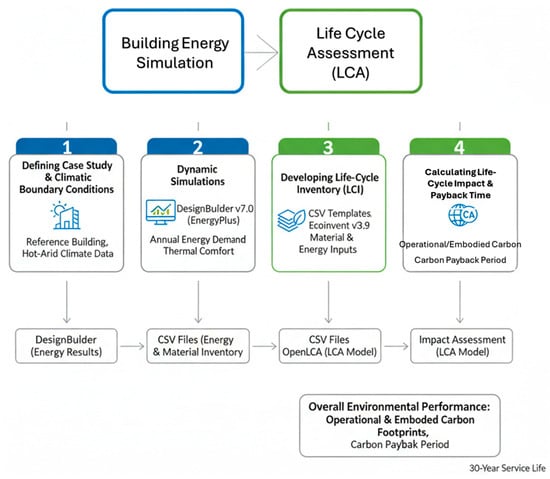
Figure 1.
Schematic framework integrating Design Builder energy simulation with OpenLCA-based lifecycle carbon assessment.
3.2. Case Study Description
The case study represents a two-story detached residential building located in Hail City, Saudi Arabia (27.52° N, 41.69° E), characterized by an extreme hot–arid climate (Köppen–Geiger classification BWh). The building has a total floor area of 272 m2 and a conditioned area of 240 m2, with reinforced concrete structural walls and thermally insulated assemblies that comply with the minimum thermal requirements of the Saudi Building Code (SBC) []. The residential unit accommodates six occupants and is typical of contemporary housing developments in the region. Figure 2 presents the building model facades, layout and architectural plans. Furthermore, as detailed in Table 2, the construction assemblies, including the ground floor, first floor, roof, and walls, are specified, revealing through architectural documentation a lack of integrated environmental design strategies.

Figure 2.
Illustrations of the analyzed residential building model, including: (a) an external rendering; (b) a satellite view providing contextual location (the dashed circle refers to the selected investigated building), along with architectural layouts for (c) the ground floor and (d) the first floor. (e) South façade showing 12 m2 glazing area used in simulations.

Table 2.
Thermal properties of building envelope components and comparison with SBC requirements [].
The building envelope comprises insulated concrete walls, a flat reinforced concrete roof, and a thermally insulated ground slab. A 12 m2 south-facing glazed façade was modeled to represent the window systems under investigation. The climatic data were obtained from a Typical Meteorological Year (TMY) weather file for Hail City, derived from the EnergyPlus Weather (EPW) database. The simulation adopted local climatic conditions of high solar irradiance, peak summer temperatures exceeding 45 °C, and average relative humidity below 30%.
3.3. Glazing Configurations
Five glazing configurations were analyzed, varying by the number of polycarbonate layers and the inclusion of argon gas and nanogel insulation in addition to the conventional single 3 mm float glass pane (C0). C0 represents standard glazing used in typical residential construction. The first configuration (C1) utilized a single 3 mm polycarbonate sheet, reflecting the low-cost glazing practice prevalent in local residential and institutional buildings across the hot–arid Saudi regions. Configurations C2 through C5 consisted of double-layer polycarbonate assemblies with either air or argon gas cavities and varying nanogel insulation layers. This range of cases (C0–C5) allowed a systematic comparison between traditional glass and emerging polycarbonate–nanogel glazing systems under identical boundary conditions. All glazing systems were modeled with thermally broken aluminum frames to minimize conductive heat transfer through the façade. The selected configurations were chosen based on their prevalence in previous studies and potential for improved insulation in extreme climates [,]. Table 3 shows the specifications of each window case.

Table 3.
Thermal and optical properties of the evaluated glazing configurations.
3.4. Energy Simulation Setup
The building performance was simulated using Design Builder v7.0, which leverages the EnergyPlus calculation engine for multi-zone thermal, daylight, and HVAC analysis. The model was constructed by importing 2D architectural drawings in DXF format, with material properties and building geometry defined to reflect the actual case study. The climatic conditions of Hail City (Köppen–Geiger classification BWh) were represented using a Typical Meteorological Year (TMY) data file. This file was sourced from Hail Airport’s weather station for the year 2021, obtained from the National Center for Meteorology and converted to the required EPW format for simulation.
Internal loads were configured to represent realistic operational conditions. An occupancy density of 0.05 persons/m2 was applied in accordance with ASHRAE Standard 90.1, with a corresponding activity schedule from 08:00 to 23:00. Internal gains from occupants, lighting, and appliances were modeled as sensible and latent heat sources. The HVAC system was defined as a split-unit air-conditioning system with a coefficient of performance (COP) of 3.2 and variable-speed control. Natural ventilation was permitted when outdoor temperatures fell below 26 °C. Furthermore, daylight sensors were implemented to control artificial lighting, maintaining a minimum illuminance of 300 lx. The simulation accounted for various glazing systems, including polycarbonate windows, with their specific thermal properties. A comprehensive description of the building’s input parameters and attributes is provided in Table 4.

Table 4.
Summary of building energy model parameters.
The cooling system was modeled as a split-type air conditioner with a Coefficient of Performance (COP) of 3.2, consistent with the efficiency range (3.0–3.3) reported by the Saudi Energy Efficiency Center for residential systems []. This assumption also aligns with previous validated studies on energy simulation of Saudi residential buildings [,].
Each glazing case was simulated under identical boundary and operational conditions to ensure comparability. Output included annual energy use, HVAC peak load, and indoor thermal comfort metrics such as operative temperature and Predicted Mean Vote (PMV). Energy consumption values were normalized by conditioned floor area (kWh/m2·yr). Results were automatically exported in CSV format for integration with the LCA stage. To ensure seamless data transfer between Design Builder and OpenLCA, simulation outputs (energy use, end-use breakdowns, and CO2 emissions) were exported as structured CSV files and processed using Python v3.13.0 scripts to align functional units and temporal boundaries between tools. This ensured a one-to-one correspondence between operational and embodied data streams.
3.5. Model Validation
The simulation model was validated against empirical data to ensure reliability and minimize performance gaps between predicted and actual building behavior. Validation was performed for both thermal performance and energy consumption.
3.5.1. Thermal Validation
The model’s thermal accuracy was assessed by comparing simulated temperatures against measured data from an unoccupied period in August 2018. Hourly indoor air temperatures were recorded in four zones—the dining room, guest room, master bedroom, and kitchen—using iButtons data loggers (DS1921H-F5 Thermochron; manufactured by Maxim Integrated, San Jose, CA, USA), as shown in Figure 3. A comparison of the simulated and measured data (Figure 4) demonstrated a strong agreement. Statistical analysis confirmed this, revealing correlation coefficients of 0.874, 0.872, 0.829, and 0.869 for the dining room, guest room, master bedroom, and kitchen, respectively. The corresponding R2 values were 0.76, 0.76, 0.69, and 0.75. Slightly larger deviations were observed in the guest and master bedrooms, which can be attributed to their greater exposure to external walls on multiple orientations (south and west for the guest room; north, east, and roof for the master bedroom). The slightly lower R2 value (0.69) obtained for the master bedroom can be attributed to occupant-related variability, including irregular use of air conditioning, night-time occupancy, and door openings that affected localized airflow and temperature distribution. These behavioral factors were not explicitly modeled in the simulation, resulting in small but acceptable deviations. Overall, the validation results remain within the acceptable accuracy range (R2 > 0.6) for dynamic thermal simulation in occupied environments. The dining room was the only zone where measured temperatures consistently exceeded simulated values, likely due to solar heat gain through its single south-facing window. The mean bias error (MBE) and coefficient of variation of the root mean square error (CVRMSE) were calculated following ASHRAE Guideline 14 to quantify model calibration accuracy. The MBE values ranged between –3.4% and +4.8%, while CVRMSE values were below 8.5% for all monitored zones. These fall well within the acceptable thresholds for calibrated residential models (MBE < ±10%, CVRMSE < 15%), confirming the high reliability of the simulation outputs.

Figure 3.
Instrumentation layout for indoor temperature monitoring. Blue dashed squares refer to the positions of the installed measurement devices.
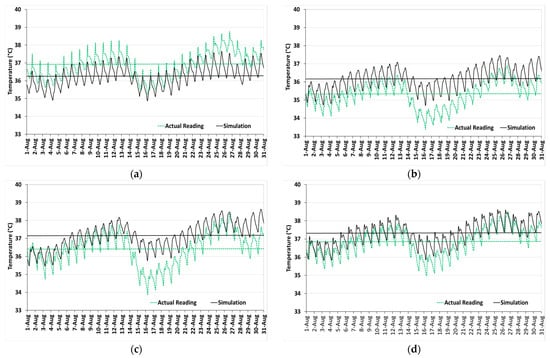
Figure 4.
Thermal performance validation: simulated versus empirical temperature data for the (a) dining room, (b) guest room, (c) master bedroom, and (d) kitchen.
Since utility-bill data were unavailable during the monitoring period, it is acknowledged that this validation was carried out in an unoccupied environment. However, hourly temperature validation in accordance with ASHRAE Guideline 14 (MBE < ±10%, CVRMSE < 15%) guarantees that the thermal response and envelope performance of the building are appropriately depicted. To further validate whole-building energy predictions and related LCA results, future work should expand the validation framework using monitored operational data from occupied residential buildings.
3.5.2. Energy Consumption Validation
The model’s predictive accuracy for total energy use was validated by comparing simulated results against actual electricity bills. The simulated consumption included loads from the HVAC, lighting, and equipment systems. The comparison, illustrated in Figure 5, showed an excellent correlation between the modeled and actual data. The coefficient of determination (R2) was 0.98, with a mean absolute error of 12.4% between the simulated and measured monthly consumption. This discrepancy is likely due to assumptions in occupant behavior schedules, which were based on a conventional Saudi lifestyle. The largest variances occurred during summer months, a period when actual energy use dropped significantly, possibly due to occupants traveling abroad—a real-world variable not captured in the standard occupancy schedule.

Figure 5.
Comparison between simulated and measured total energy consumption.
3.6. Life Cycle Assessment and Carbon Payback Framework
The lifecycle inventory was constructed to capture all relevant material and energy inputs associated with each glazing configuration. Material quantities were determined from the glazing design specifications and expressed per functional unit of 1 m2 of window area over a 30-year service life. Emission factors were derived from the Ecoinvent v3.9 database. Table 5 summarizes the inventory data used in the embodied carbon assessment.

Table 5.
Lifecycle inventory data for glazing materials (per 1 m2).
Transportation impacts were estimated assuming an average delivery distance of 500 km by medium-duty truck (0.12 kg CO2/ton·km). The system boundary encompassed cradle-to-operation phases (A1–A3 + B6), excluding maintenance and end-of-life stages due to data limitations. Data were prepared in CSV format for import into OpenLCA.
The LCA was performed in OpenLCA v1.11 using the IPCC 2021 GWP100 impact assessment method. The main category analyzed was Global Warming Potential (GWP) expressed in kilograms of CO2 equivalent.
Operational CO2 emissions were derived from energy simulation results and multiplied by the Saudi electricity grid emission factor (0.72 kg CO2/kWh). Embodied carbon was calculated by aggregating material-based emissions from the LCI. The total lifecycle emissions were computed as:
where:
= embodied carbon (kg CO2);
= annual energy use (kWh/yr);
= emission factor (kg CO2/kWh);
= lifetime (30 years).
Data consistency was verified through cross-checks and sensitivity tests. To assess the environmental return on investment, the carbon payback period (tₚ) was calculated as the time required for the operational carbon savings of an advanced glazing configuration to offset its additional embodied carbon compared with the baseline. The formula is given as:
where:
= embodied carbon of case i;
= embodied carbon of baseline system;
= annual operational carbon of case i;
= annual operational carbon of baseline system.
A payback period shorter than the service life (30 years) indicates a net environmental benefit. Two primary parameters were examined to evaluate the robustness of the results:
- 1.
- Grid Emission Factor (GEF):
Simulations were repeated for GEF values of 0.72, 0.60, 0.45, and 0.30 kg CO2/kWh to reflect potential decarbonization cases of the Saudi power grid.
- 2.
- Service Life:
The 30-year reference life span varied between 20 and 50 years to assess the influence of longevity on lifecycle totals and payback time. In addition, a ± 20% variation in material emission factors was applied through a Monte Carlo analysis (500 iterations) to quantify uncertainty in embodied carbon estimates. Operational energy remained the dominant contributor in all sensitivity cases, confirming the reliability of the main results.
4. Results
This section presents the quantitative outcomes of the building energy simulation and lifecycle carbon assessment (LCA) conducted for the five glazing configurations (C1–C5). Results are categorized into annual energy performance, embodied emissions, total lifecycle carbon, carbon payback, thermal comfort, and sensitivity analysis.
4.1. Energy and Thermal Performance
As illustrated in Figure 6, the conventional single-glazed glass reference (C0) recorded the highest annual cooling energy consumption at 25,410 kWh, followed by the single polycarbonate case (C1) at 24,200 kWh. The 4.8% reduction observed from C0 to C1 is attributed to polycarbonate’s lower thermal conductivity (0.19 W/m·K) relative to glass (1.0 W/m·K), which moderately improved the envelope’s heat resistance. Further enhancements were achieved through multi-layer polycarbonate assemblies, with C2 (air cavity) and C3 (argon cavity) showing 7.2% and 7.9% reductions relative to C1, respectively. The inclusion of nanogel in C4 and C5 significantly improved performance, yielding annual cooling energy of 18,760 and 17,182 kWh, equivalent to reductions of 22.5% and 32.4% compared to the conventional glass reference (C0). These results confirm that the shift from traditional glass to advanced polymeric glazing can deliver substantial energy savings under hot–arid climatic conditions.
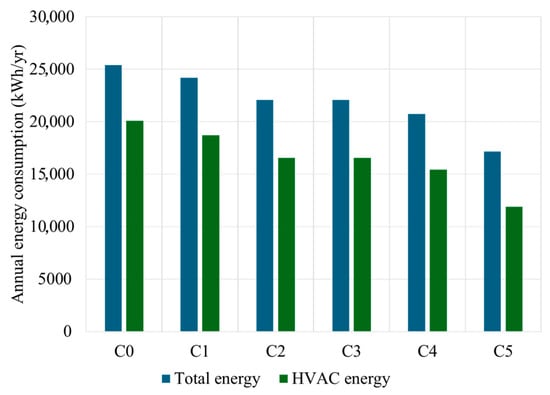
Figure 6.
Annual total and HVAC energy consumption for glazing configurations C0–C5, showing progressive reduction from conventional single glass to advanced nanogel–argon systems.
The annual energy consumption results are summarized in Table 6. The glass reference (C0) exhibited the highest total energy demand of 25,410 kWh/year, with cooling loads contributing 79.1% of total consumption. The baseline single polycarbonate (C1) system recorded a total energy demand of 24,200 kWh/year, with cooling loads accounting for 77.3%, lighting for 17.4%, and equipment loads for 5.3%. Upgrading to double-layer polycarbonate glazing (C2 and C3) produced 8.8% energy savings relative to C1, reducing total consumption to approximately 22,070 kWh/year. Substituting air with argon (C3) resulted in negligible further improvement, reflecting the limited benefit of argon gas under high solar radiation conditions.

Table 6.
Annual energy consumption and operational CO2 emissions for glazing configurations (window area = 12 m2; grid factor = 0.72 kg CO2/kWh).
Integrating nanogel insulation produced the greatest improvement. The PC + nanogel system (C4) reduced annual energy use by 14.3%, while the nanogel–argon composite (C5) achieved the best performance, decreasing total energy demand to 17,182 kWh/year—a 32.4% reduction relative to the conventional glass reference (C0). This improvement was primarily attributed to lower thermal transmittance (U-value = 0.374 W/m2·K) and reduced solar heat gain coefficient (SHGC = 0.31).
In terms of thermal comfort, nanogel-enhanced glazing notably reduced indoor overheating. Operative temperature profiles revealed a 4–5 °C reduction in summer peaks compared to both glass (C0) and single polycarbonate (C1). Consequently, the number of discomfort hours (operative temperature > 27 °C) decreased significantly, improving occupant comfort. The peak cooling load followed a similar trend, decreasing from 23.5 kW in C0 to 22.4 kW in C1 and 14.6 kW in C5, representing a 38% reduction relative to the glass reference. This suggests the potential for downsizing HVAC systems, yielding both operational and capital cost savings—an important practical advantage in high-demand residential applications.
Although the U-value of the argon-filled configuration (C3) was slightly lower than that of the air-filled case (C2), the simulation results indicated a negligible difference in annual cooling energy. This occurs because, under hot–arid conditions, radiative and solar-gain mechanisms dominate the total heat transfer through glazing, while the effect of the cavity gas on convection is relatively minor. Consequently, argon’s lower thermal conductivity (0.016 W/m·K) compared with air (0.024 W/m·K) contributes little to overall performance when the glazing is primarily exposed to strong solar radiation and high outdoor air temperatures.
The comparison illustrated in Figure 6 shows a progressive reduction in total energy use from 25,410 kWh/yr in the glass reference (C0) to 17,182 kWh/yr in the nanogel–argon composite (C5). This translates to an absolute annual saving of 8228 kWh, equivalent to approximately 2960 kg CO2 per year based on the Saudi grid emission factor (0.36 kg CO2/kWh). Over a 30-year operation period, this results in an accumulated carbon saving exceeding 88 tonnes CO2 per dwelling. If implemented across 100,000 typical residential units nationwide, adopting C5-type glazing could prevent more than 8.8 million tonnes of CO2 emissions—demonstrating its large-scale environmental potential.
The negligible difference observed between C2 (double polycarbonate with air) and C3 (double polycarbonate with argon) highlights that argon gas filling offers limited thermal benefit under the high solar irradiance and elevated ambient temperatures typical of hot–arid regions. In such conditions, radiative and conductive heat transfer through glazing layers is dominated by solar gain rather than convection within the cavity, rendering the low thermal conductivity of argon (0.016 W/m·K) less influential. Consequently, the marginal improvement of only 0.03 W/m2·K in U-value does not justify the additional manufacturing complexity, sealing requirements, or cost associated with gas filling. These results suggest that, in climates like Hail, performance gains are primarily achieved through the nanogel insulation layer, which effectively mitigates both conductive and radiative heat transfer. Argon may thus serve better as a supplementary enhancement in mixed or heating-dominated climates rather than as a standalone improvement in cooling-oriented environments.
4.2. Lifecycle Carbon Performance
The embodied carbon emissions from material production and transportation (A1–A3 stages) are presented in Table 7. The conventional single-glazed glass reference (C0) exhibited embodied emissions of approximately 438 kg CO2, slightly higher than the polycarbonate model (C1), which recorded the lowest embodied impact (427 kg CO2). This difference reflects the higher density and melting energy of glass compared with polycarbonate. Configurations C2 and C3 nearly doubled the embodied impact (~816 kg CO2) due to the inclusion of a second layer and cavity materials, while the nanogel-enhanced systems (C4 and C5) reached ~996 kg CO2, mainly attributed to the high energy intensity of nanogel synthesis.

Table 7.
Embodied CO2 emissions for glazing configurations (A1–A3 stages).
When integrating both operational and embodied impacts, the total lifecycle CO2 emissions over 30 years followed a similar trend to the energy results, with the conventional glass reference (C0) showing the highest total impact. Operational emissions dominated the total footprint across all configurations, exceeding 97% of total emissions even in high-embodied systems. For C0, the 30-year operational emissions reached approximately 527,600 kg CO2, compared to only 438 kg from manufacturing. The single polycarbonate sheet (C1) reduced total emissions to 523,147 kg CO2, while the advanced multi-layer systems (C2–C5) achieved progressive reductions with increasing thermal performance as shown in Table 8.

Table 8.
Lifecycle CO2 emissions and carbon payback periods for each glazing configuration.
The total 30-year emissions decreased from 527,600 kg CO2 in C0 to 372,127 kg CO2 in C5—representing an overall 29.4% reduction relative to conventional glass and 28.9% relative to the polycarbonate baseline (C1). Intermediate systems such as C4 achieved reductions of approximately 15.0%, whereas C2 and C3 yielded more moderate decreases of about 9.5%. The nanogel–argon composite (C5) demonstrated the most significant improvement due to its lowest operational energy consumption.
Figure 7 illustrates the significant difference between the operational and embodied CO2 emissions for glazing cases C0–C5, confirming that operational energy remains the dominant lifecycle contributor. The carbon payback analysis indicates that all advanced configurations achieve positive carbon recovery within the first five years of operation, while the nanogel–argon composite (C5) attains carbon neutrality within just 1.1 years. The inclusion of C0 as a benchmark clarifies that substituting conventional single-glazed glass with any polycarbonate-based alternative yields immediate environmental advantages, with further benefits realized through nanogel integration.
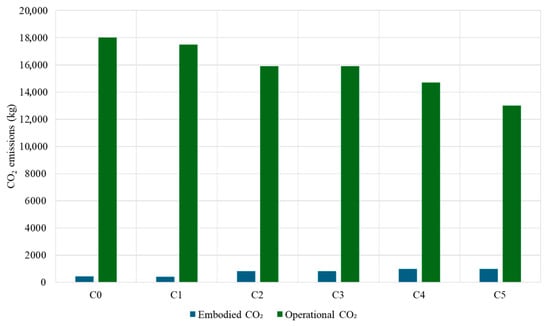
Figure 7.
The significant difference between the operational and embodied CO2 emissions for glazing cases C1–C5.
The 29% reduction in total lifecycle emissions obtained for the C5 system aligns closely with the 27–32% savings reported for aerogel or multi-layer glazing systems under comparable climatic conditions [,]. However, the present results show a faster carbon payback period—approximately 1.1 years—due to the use of lightweight polycarbonate substrates with lower embodied carbon than glass. The transition from traditional glass (C0) to the nanogel–argon configuration (C5) corresponds to an absolute reduction of nearly 156,000 kg CO2 over a 30-year building life, emphasizing the strong decarbonization potential of these advanced glazing systems.
This analysis confirms that polycarbonate–nanogel composites not only enhance energy efficiency but also deliver rapid environmental returns when evaluated over their service lifespan, demonstrating their viability as high-performance, low-carbon alternatives to conventional glass glazing in hot–arid climates.
4.3. Sensitivity and Uncertainty Analysis
The sensitivity analysis was conducted to assess the robustness of lifecycle carbon results under variations in the grid emission factor (GEF), service life, and material emission factors. To account for uncertainties in lifecycle assessment parameters, additional sensitivity tests were conducted for service life (30–60 years), embodied carbon factors (±20%), and grid electricity emission factor (0.30–0.72 kg CO2/kWh). Results showed that variations in embodied parameters or lifespan assumptions had a limited influence (<4%) on total lifecycle emissions, while operational impacts continued to dominate the carbon profile. The nanogel–argon configuration (C5) remained the most favorable option across all tested scenarios, confirming the robustness of the environmental conclusions.
- i.
- Grid Emission Factor (GEF):
Reducing the GEF from 0.72 to 0.3 kg CO2/kWh—representing partial grid decarbonization—slightly extended the carbon payback of C5 from 1.1 to 1.8 years, without altering the ranking of cases.
- ii.
- Service Life:
Shortening the service life from 30 to 20 years increased the relative embodied impact but retained C5 as the most efficient configuration. Extending the service life to 50 years amplified cumulative savings.
- iii.
- Material Emission Factors:
A ±20% variation in embodied emission factors produced less than 5% change in total lifecycle emissions. Monte Carlo simulation (500 iterations) confirmed that operational energy remained the dominant determinant of lifecycle carbon outcomes.
To further investigate the influence of design parameters on the overall performance, an extended sensitivity analysis was carried out for the optimal nanogel–argon glazing configuration (C5). Increasing the cavity depth from 13 mm to 20 mm led to a reduction in the overall U-value from 0.374 to 0.295 W/m2·K, corresponding to an additional 3.7% decrease in annual cooling energy demand. Conversely, reducing the nanogel insulation layer thickness from 10 mm to 6 mm resulted in a 4.2% increase in annual energy use due to higher conductive heat transfer through the glazing assembly. Despite these geometric variations, the carbon payback period remained within a narrow range of 0.9–1.3 years, indicating that the environmental benefits of the nanogel-based glazing system are highly resilient and maintainable under moderate design adjustments.
The consistent ranking of C5 across all uncertainty scenarios reinforces the reliability of the integrated simulation-LCA framework and strengthens confidence in the proposed policy recommendations.
5. Discussion
The simulation and lifecycle assessment results demonstrate that glazing systems incorporating nanogel insulation and inert gas filling significantly enhance the energy and environmental performance of residential buildings in hot–arid climates. The addition of a conventional glass reference (C0) clarified the comparative advantages of the proposed systems. The single polycarbonate glazing (C1) reduced annual cooling energy by approximately 4.8% relative to conventional glass (C0), while the nanogel–argon composite (C5) achieved a 32% reduction in cooling energy and a 28.9% reduction in total lifecycle carbon emissions. These results confirm the dominant influence of window thermal transmittance and solar heat gain on cooling energy consumption.
The improved performance of nanogel-based glazing arises from its exceptionally low thermal conductivity (~0.018 W/m·K) and its infrared scattering characteristics, which limit both conductive and radiative heat transfer. Furthermore, its moderate visible light transmittance (VLT = 0.27–0.29) maintains adequate daylight levels while mitigating excessive solar gain, aligning with the principle of selective solar control required in hot–arid climates.
The reduction in peak cooling load by 32% further indicates that nanogel glazing effectively suppresses thermal spikes, contributing to improved occupant comfort and potential downsizing of HVAC systems. Even when compared with conventional glass, the advanced polycarbonate-based glazing demonstrated superior thermal stability, confirming its suitability for lightweight envelope systems in hot regions. While double-layer polycarbonate glazing (C2 and C3) improved performance moderately, the marginal difference between air and argon gaps confirms that gas filling alone cannot achieve substantial savings without simultaneous reduction in SHGC. This finding underscores the need to combine insulation and optical optimization to achieve balanced façade performance in high-irradiance regions such as northern Saudi Arabia.
Including a conventional single-glass case strengthens the external validity of the results. The 32% reduction in annual cooling energy achieved by C5 relative to C0 aligns closely with the 27–34% savings reported by previous studies for aerogel-enhanced glazing systems in similar climatic zones [,,]. The present study, however, demonstrates a faster carbon payback period (≈1.1 years) owing to the lightweight, low-embodied polycarbonate structure.
The outcomes of this study are consistent with findings reported in previous investigations. Abdelhafez and Ragab [] observed a 27% reduction in cooling energy when using aerogel-insulated glazing in Aswan’s hot–arid climate, while Abuhenidy et al. [] reported 11% reductions in similar configurations under hot–arid conditions. Likewise, Li et al. [] found that aerogel glazing reduced building cooling demand by 32% in subtropical climates, emphasizing its strong potential for hot regions.
The embodied carbon results align with the ranges reported by Vilches et al. [] confirmed that embodied impacts of façade materials typically account for less than 2% of total lifecycle emissions in climates dominated by cooling energy use. Moreover, the carbon payback period below two years for the advanced systems corresponds well with the values reported by De Wolf et al. [] and Zhou et al. [], reinforcing the rapid environmental return on material investments.
The notably short carbon payback observed in this study results from the combined influence of three primary factors. First, the Saudi electricity grid remains relatively carbon-intensive (≈0.72 kg CO2/kWh), meaning that operational energy savings yield substantial carbon reductions per unit of electricity conserved. Second, the extreme cooling loads in Hail’s hot–arid climate amplify the annual energy demand, thereby increasing the marginal benefit of thermal envelope improvements. Third, the embodied carbon of the polycarbonate-nanogel glazing system is considerably lower than that of conventional glass or double-glazed units, due to its reduced mass and simpler fabrication processes. Together, these conditions accelerate the recovery of embodied impacts and explain the rapid carbon payback period achieved by the C5 configuration.
While the nanogel–argon configuration (C5) delivered the highest energy and carbon savings, its relatively low visible light transmittance (VLT = 0.27) introduces a potential daylight–comfort trade-off. Preliminary daylight-factor simulations indicated that the average daylight level decreased from 2.4% in C0 to 1.6% in C5. Although these values remain within acceptable limits for residential interiors, future studies should assess daylight autonomy and potential increases in artificial lighting energy to ensure overall occupant satisfaction. Exploring hybrid configurations with selective coatings or partially transparent nanogel zones could balance thermal efficiency and daylight quality.
However, the present study extends prior work by applying a fully integrated simulation–LCA framework, combining dynamic energy modeling in Design Builder with OpenLCA-based carbon quantification using region-specific emission factors. This approach ensures that both operational and embodied impacts are represented under consistent system boundaries and local energy mix conditions, thus enhancing the reliability of comparative results. The findings have direct implications for building design practices and energy policy in Saudi Arabia. First, the results confirm that glazing systems play a pivotal role in reducing the cooling energy demand, which constitutes over two-thirds of residential electricity consumption in the country. Integrating nanogel-enhanced glazing can significantly alleviate this load, contributing to the targets of Saudi Vision 2030 for energy efficiency and carbon reduction.
From a design perspective, the nanogel–argon composite system (C5) represents a technically and environmentally optimal configuration. Despite its slightly higher embodied carbon, the rapid payback (≈1 year) makes it favorable for widespread adoption in newly constructed and retrofitted residential buildings. Furthermore, the substantial peak load reduction highlights its potential to reduce HVAC equipment sizing, lowering both upfront capital costs and long-term energy expenses. When translated into economic and carbon terms, the results indicate that each dwelling equipped with the nanogel–argon glazing could achieve annual electricity savings of about 7 MWh and reduce utility costs by nearly 1050 SAR per year (assuming 0.15 SAR/kWh). At the city scale, upgrading 10% of the residential stock in Hail City—approximately 55,000 units—would yield cumulative annual savings of 385 GWh and 276,000 t CO2. Such quantified outcomes substantiate the inclusion of high-performance glazing incentives in local retrofit programs and directly support Saudi Vision 2030’s target of >30% reduction in residential energy intensity by 2030.
To contextualize the national impact, the cumulative 7.5 million t CO2 reduction achievable by adopting the C5 glazing across 100,000 residential units is equivalent to the annual carbon sequestration of approximately 280 million mature trees (assuming 26.5 kg CO2 per tree per year []). This equivalence illustrates the scale of potential environmental benefits when translating façade-level improvements to city- or country-level implementation.
At the policy level, the results advocate for the inclusion of lifecycle carbon metrics within the Saudi Building Code (SBC) and local green building rating systems. Current standards emphasize U-value compliance but overlook embodied emissions. Incorporating LCA-based evaluation would promote material transparency, support the use of low-carbon façade components, and guide incentives for high-performance glazing technologies. Although the present study did not include an explicit analysis of local manufacturing or transport-related emissions, future research should quantify how regional production of polycarbonate and nanogel panels might influence embodied carbon and cost. Such an assessment would provide evidence-based support for circular economy strategies under Saudi Vision 2030 and help identify opportunities for sustainable material localization in the Saudi construction sector.
6. Study Limitations
Although this study provides robust insights, several limitations should be acknowledged. The analysis focused on a single representative residential building in the hot–arid climate of Hail City; performance may vary across other Saudi climatic zones such as Jeddah (hot-humid) or Abha (temperate). While this approach ensured contextual relevance, future research should extend the same simulation–LCA framework to multiple climatic zones and diverse building typologies (e.g., apartments, villas, and educational facilities) to assess the generalizability and scalability of the findings across the Kingdom. Such expansion would help quantify how variations in occupancy density, façade geometry, and building function influence the relative benefits of polycarbonate–nanogel glazing systems.
Additionally, maintenance and end-of-life stages (C1–C4) were excluded from the LCA due to limited data availability. Including these stages in future assessments will offer a more complete lifecycle profile. Experimental field testing of nanogel–polycarbonate systems under real operating conditions would further validate the simulated results and allow for the calibration of optical degradation over time.
The exclusion of maintenance, replacement, and end-of-life (C1–C4) stages introduces an inherent limitation to the cradle-to-operation boundary adopted in this study. For a 30-year service life, maintenance-related impacts—such as potential resealing of glazing joints every 10–15 years or partial argon refilling—could contribute an additional 2–4% to total lifecycle carbon emissions based on literature estimates for curtain wall systems. The long-term durability and optical stability of nanogel-filled polycarbonate panels also require further verification under real desert exposure. Accelerated aging studies indicate that UV-stabilized polycarbonate retains approximately 90% of its transmittance after a decade, but the behavior of encapsulated nanogel layers beyond 15–20 years remains uncertain. Future work should therefore include empirical durability testing and full cradle-to-grave LCA cases encompassing maintenance, refurbishment, and recycling processes to capture the complete environmental profile of these advanced glazing systems.
Finally, incorporating techno-economic and occupant-comfort analyses could provide a more holistic evaluation, enabling designers and policymakers to balance energy savings, lifecycle emissions, and cost-effectiveness simultaneously. Future studies should also incorporate extended parametric sensitivity analysis covering variables such as window-to-wall ratio (WWR), façade orientation, and cavity thickness to identify thresholds, since glazing performance exhibits nonlinear responses. Such analysis would provide deeper insights into façade optimization potential under varying design conditions.
7. Conclusions
This study developed an integrated framework combining dynamic energy simulation and lifecycle carbon assessment (LCA) to evaluate advanced polycarbonate glazing systems for residential buildings in the hot–arid climate of Hail City, Saudi Arabia. Six configurations were examined, including a conventional single-glazed glass reference (C0), single-layer polycarbonate (C1), and four advanced multi-layer systems (C2–C5) enhanced with air, argon, and nanogel insulation.
Results show that nanogel integration markedly enhances energy and carbon performance compared with both glass and polycarbonate baselines. The nanogel–argon composite (C5) achieved the highest efficiency, reducing annual cooling energy by 32% and lifecycle carbon emissions by 28.9% relative to glass (C0). It also decreased the peak cooling load by 35% and achieved a carbon payback period of approximately 1.1 years, confirming a rapid environmental return on investment.
The findings highlight the importance of lifecycle thinking in façade design and policy. Incorporating LCA-based criteria into Saudi building codes and procurement systems would enhance transparency and promote the localization of low-carbon façade materials. Strengthening public–private partnerships for nanogel and polycarbonate production aligns with Saudi Vision 2030 objectives for energy efficiency, carbon neutrality, and circular economy transition.
Future research should extend this framework to other climatic zones, including end-of-life phases, and validate field performance. Integration with adaptive shading or photovoltaic layers presents a promising direction toward net-zero, high-performance building envelopes for hot–arid regions.
Author Contributions
Conceptualization, M.H.H.A., S.A. and A.R.; methodology, M.H.H.A., A.S.H.A. and A.R.; software, A.R. and A.S.H.A.; validation, M.H.H.A., S.A. and A.A.; formal analysis, A.R.; investigation, S.A., A.A.A. and A.R.; resources, S.A. and A.A.A.; data curation, S.A. and M.H.H.A.; writing—original draft preparation, A.R., M.H.H.A. and A.A.A.; writing—review and editing, S.A. and A.R.; visualization, A.A. and M.H.H.A.; project administration, S.A.; funding acquisition, S.A. All authors have read and agreed to the published version of the manuscript.
Funding
This work was supported and funded by the Deanship of Scientific Research at Imam Mohammad Ibn Saud Islamic University (IMSIU) (grant number IMSIU-DDRSP2502).
Data Availability Statement
The original contributions presented in this study are included in the article. Further inquiries can be directed to the corresponding authors.
Conflicts of Interest
The authors declare no conflicts of interest.
References
- Saudi Energy Efficiency Center (SEEC). Annual Report; Saudi Energy Efficiency Center: Riyadh, Saudi Arabia, 2023. [Google Scholar]
- Aloshan, M.A. Achieving near-zero energy in hot climates: Retrofitting building envelopes for existing homes. Heliyon 2025, 11, e42170. [Google Scholar] [CrossRef] [PubMed]
- Labban, A.; Farahat, A. Effect of major dust events on ambient temperature and solar irradiance components over Saudi Arabia. Atmosphere 2023, 14, 408. [Google Scholar] [CrossRef]
- Alyami, S.H.; Alqahtany, A.; Ashraf, N.; Osman, A.; Aldossary, N.A.; Almutlaqa, A.; Al-Maziad, F.; Alshammari, M.S.; Al-Gehlani, W.A.G. Impact of location and insulation material on energy performance of residential buildings as per Saudi Building Code (SBC) 601/602 in Saudi Arabia. Materials 2022, 15, 9079. [Google Scholar] [CrossRef]
- Hamida, A.; Alsudairi, A.; Alshaibani, K.; Alshamrani, O. Parametric study of the impact of building envelope systems on embodied and operational carbon of residential buildings. Int. J. Build. Pathol. Adapt. 2022, 40, 753–774. [Google Scholar] [CrossRef]
- Menkabo, M.M.; Alhaji, M.M.; Budaiwi, I.M.; Abdou, A.A. Thermo-environmental performance of polycarbonate materials as a glazing substitute in hot climates. Adv. Build. Energy Res. 2024, 18, 1–33. [Google Scholar] [CrossRef]
- Mohammed, M.A.; Menkabo, M.M.; Budaiwi, I.M. Assessment of polycarbonate material as a sustainable substitute for glazing in hot climates. Int. J. Sustain. Energy 2023, 42, 954–974. [Google Scholar] [CrossRef]
- Gomaa, M.M.; Abdallah, A.S.H.; Aloshan, M.A.; Ragab, A. A Comparative Analysis of Glazing Technologies for Energy-Efficient Buildings in Jeddah City, Saudi Arabia. Buildings 2025, 15, 1477. [Google Scholar] [CrossRef]
- Mohamed, A.F.; Amir, A.A.; Ragab, A. The effect of aerogel glazing on daylight and heat gain in school buildings in hot and dry climate. Environ. Dev. Sustain. 2024, 1–22. [Google Scholar] [CrossRef]
- Aly, A.M.; Hassn, M.H.; Abdel Rady, Y.R.; Mohammed, A.T. The effect of using nano-materials in external openings on energy consumption in hot desert climate. J. Eng. Sci. 2020, 48, 468–477. [Google Scholar] [CrossRef]
- Mahmoud, A.R. Investigating the impact of different glazing types on the energy performance in hot arid climate. J. Adv. Eng. Trends 2022, 42, 69–84. [Google Scholar] [CrossRef]
- Abdelhafez, M.H.H.; Aldersoni, A.A.; Gomaa, M.M.; Noaime, E.; Alnaim, M.M.; Alghaseb, M.; Ragab, A. Investigating the thermal and energy performance of glazing systems in the context of Hail City, KSA. Buildings 2023, 13, 752. [Google Scholar] [CrossRef]
- Abdelrady, A.; Abdelhafez, M.H.H.; Ragab, A. Use of insulation based on nanomaterials to improve energy efficiency of residential buildings in a hot desert climate. Sustainability 2021, 13, 5266. [Google Scholar] [CrossRef]
- Mujeebu, M.A.; Ashraf, N.; Alsuwayigh, A. Energy performance and economic viability of nano aerogel glazing and nano vacuum insulation panel in multi-story office building. Energy 2016, 113, 949–956. [Google Scholar] [CrossRef]
- Tavares, V.; Freire, F. Life cycle assessment of a prefabricated house for seven locations in different climates. J. Build. Eng. 2022, 53, 104504. [Google Scholar] [CrossRef]
- Gutai, M.; Mok, B.; Cavana, G.; Kheybari, A.G. Global carbon viability of glass technologies: Life-cycle assessment of standard, advanced and water-filled glass (WFG) building envelopes. Appl. Energy 2024, 367, 123281. [Google Scholar] [CrossRef]
- Liu, Y.; Yan, J.; Hu, Z.; Chen, Y.; Lv, L. Evaluation the life cycle carbon emissions of the aerogel glazing under different weather conditions. J. Clean. Prod. 2024, 437, 140651. [Google Scholar] [CrossRef]
- O’Neill, R.; Window, A.; Kenway, S.; Dargusch, P. Integrated operational and life-cycle modelling of energy, carbon and cost for building façades. J. Clean. Prod. 2021, 286, 125370. [Google Scholar] [CrossRef]
- Awolesi, O. A Multi-method Approach to Evaluating Indoor Environmental Quality and Energy Performance in Residential College Buildings in a Humid Subtropical Region. Energy Built Environ. 2025. [Google Scholar] [CrossRef]
- Awolesi, O.; Ghafari, F.; Reams, M. Indoor Environmental Quality Assessment in the Built Environment: A Critical Synthesis of Methodologies and Energy Integration Practices. Energy Built Environ. 2025. [Google Scholar] [CrossRef]
- Cabeza, L.F.; Rincón, L.; Vilariño, V.; Pérez, G.; Castell, A. Life cycle assessment (LCA) and life cycle energy analysis (LCEA) of buildings and the building sector: A review. Renew. Sustain. Energy Rev. 2014, 29, 394–416. [Google Scholar] [CrossRef]
- Antypa, D.; Petrakli, F.; Gkika, A.; Voigt, P.; Kahnt, A.; Böhm, R.; Suchorzewski, J.; Araújo, A.; Sousa, S.; Koumoulos, E.P. Life cycle assessment of building components towards NZEBs. Sustainability 2022, 14, 16218. [Google Scholar] [CrossRef]
- Elkhayat, Y.O.; Ibrahim, M.G.; Tokimatsu, K.; Ali, A.A.M. A comparative life cycle assessment of three high-performance glazing systems for office buildings in a hot desert climate zone. Clean Technol. Environ. Policy 2020, 22, 1499–1515. [Google Scholar] [CrossRef]
- Baetens, R.; Jelle, B.P.; Gustavsen, A. Aerogel insulation for building applications: A state-of-the-art review. Energy Build. 2011, 43, 761–769. [Google Scholar] [CrossRef]
- Salem, H.F.; Ibrahim, M.A.; El-Sayad, Z. Impact of nano insulating materials on energy retrofit of buildings. WIT Trans. Built Environ. 2022, 210, 49–60. [Google Scholar]
- Abuhenidy, D.; Arnaouty, S.E.; Farghaly, Y. Economic feasibility of nano aerogel glazing & phase change material glazing in office buildings. Sci. J. Fac. Fine Arts Alex. Univ. 2019, 7, 58–68. [Google Scholar]
- Nsaif, M.A.; Jalil, J.M.; Baccar, M. Numerical and Experimental Analysis of Thermal Performance in Triple-Glazed Low-E Windows for Iraqi Weather. J. Eng. Sustain. Dev. 2025, 29, 504–512. [Google Scholar] [CrossRef]
- De Wolf, C.; Pomponi, F.; Moncaster, A. Measuring embodied carbon dioxide equivalent of buildings: A review and critique of current industry practice. Energy Build. 2017, 140, 68–80. [Google Scholar] [CrossRef]
- Zhou, Y.; Yu, X.; Zhang, X. Lifecycle carbon footprints of buildings and sustainability pathways in China. Carbon Footpr. 2024, 3, 9. [Google Scholar] [CrossRef]
- Vilches, A.; Garcia-Martinez, A.; Sanchez-Montañes, B. Life cycle assessment (LCA) of building refurbishment: A literature review. Energy Build. 2017, 135, 286–301. [Google Scholar] [CrossRef]
- Kumar, D.; Maurya, K.K.; Mandal, S.K.; Halder, N.; Mir, B.A.; Nurdiawati, A.; Al-Ghamdi, S.G. A Whole-Life Carbon Assessment of a Single-Family House in North India Using BIM-LCA Integration. Buildings 2025, 15, 2195. [Google Scholar] [CrossRef]
- Yang, Y.; Wu, H.; Yang, L.; Xu, T.; Ding, Y.; Fu, P. Thermal and day-lighting performance of aerogel glazing system in large atrium building under cooling-dominant climates. Energy Procedia 2019, 158, 6347–6357. [Google Scholar] [CrossRef]
- Peng, C.; Wang, L.; Zhang, X. DeST-based dynamic simulation and energy efficiency retrofit analysis of commercial buildings in the hot summer/cold winter zone of China: A case in Nanjing. Energy Build. 2014, 78, 123–131. [Google Scholar] [CrossRef]
- Alwafi, A.A.M. Feasibility Study of Nano-Technology-Based Insulation Materials’ Usage to Decrease the Cooling Loads in High-Income Housing in KSA. In Advances in Architecture, Engineering and Technology; Springer: Heidelberg, Germany, 2022; pp. 215–226. [Google Scholar]
- Aldersoni, A.A.; Chow, D.H.C. Adapting traditional passive strategies within contemporary house to decrease high energy consumption impact in Nejd Region, Saudi Arabia. In Proceedings of the IOP Conference Series: Earth and Environmental Science, Bristol, UK, 9 December 2021; p. 012007. [Google Scholar]
- Saudi Energy Efficiency Center (SEEC). Residential Air Conditioner Efficiency Standards and Market Data Report; Saudi Energy Efficiency Center: Riyadh, Saudi Arabia, 2022. [Google Scholar]
- Alaidroos, A.; Krarti, M. Optimal design of residential building envelope systems in the Kingdom of Saudi Arabia. Energy Build. 2015, 86, 104–117. [Google Scholar] [CrossRef]
- Krarti, M.; Dubey, K.; Howarth, N. Evaluation of building energy efficiency investment options for the Kingdom of Saudi Arabia. Energy 2017, 134, 595–610. [Google Scholar] [CrossRef]
- Khan, F.A.; Ullah, Z.; Aashan, M.; Ahmad, F.; Saad, M.; Azhar, M. Life cycle assessment and energy efficiency of building façade materials: A case study of an educational building in Pakistan. J. Eng. 2025, 2025, e70047. [Google Scholar] [CrossRef]
- Li, X.; Wu, Y. A review of complex window-glazing systems for building energy saving and daylight comfort: Glazing technologies and their building performance prediction. J. Build. Phys. 2025, 48, 496–540. [Google Scholar] [CrossRef]
- Arias, P.; Bellouin, N.; Coppola, E.; Jones, R.; Krinner, G.; Marotzke, J.; Naik, V.; Palmer, M.; Plattner, G.-K.; Rogelj, J. Contribution of Working Group I to the Sixth Assessment Report of the Intergovernmental Panel on Climate Change; Technical Summary; Climate for Change: Brunswick, VIC, Australia, 2021. [Google Scholar]
Disclaimer/Publisher’s Note: The statements, opinions and data contained in all publications are solely those of the individual author(s) and contributor(s) and not of MDPI and/or the editor(s). MDPI and/or the editor(s) disclaim responsibility for any injury to people or property resulting from any ideas, methods, instructions or products referred to in the content. |
© 2025 by the authors. Licensee MDPI, Basel, Switzerland. This article is an open access article distributed under the terms and conditions of the Creative Commons Attribution (CC BY) license (https://creativecommons.org/licenses/by/4.0/).
